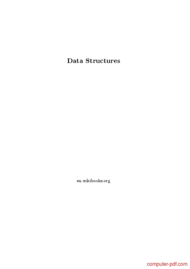Data Structures Tutorial in PDF
This book covers most of the commonly used data structures in computer science: abstract data types; Sequences; Dictionaries; Sets; Priority queues; Successors and neighbors; Integer and string searching, etc.
It describes data structures from the point of view of computer programming, with examples, and presents design techniques that allow programmers to develop their own data structures. The authors include both classical data structures, such as red-black trees and binomial queues, and a host of new data structures developed exclusively for programming languages. It also offers solutions to complex data structures and algorithms. There are multiple solutions for each problem. It comes in handy as an interview and exam guide for computer scientists.
Learning the Data Structures
Formal data structures allow programmers to mentally organize large amounts of data into relationships that can be conceptually controlled. Data structures are more advanced abstractions that allow us to perform operations on data groups. When a data structure contains operations, we can refer to the data structure as an abstract data type (sometimes abbreviated as ADT).
Each of the data structures that are covered in this book can be thought of as a single unit, each of which possesses a set of values and a set of operations that can be used to either access or modify those values. This course is organized to allow the reader to view each data structure as if it were a single entity. The performance of computer code is often expressed using a notation known as "big-oh," which stands for "big-oh."
When referring to a data structure, the notation denotes that a particular function will typically carry out its operations n times. It ought not to be too difficult to translate the pseudocode into your native language. We are significantly more concerned with the operations and the implementation strategy than we are with the structure and the implementation at the lower levels. Given that a node is nothing more than a container for a value and a container for a pointer to another node, it really shouldn't be a surprise how simple the node data structure is (as well as its implementation). No one data structure can guarantee optimal performance in every circumstance.
The primary element of the expense associated with an algorithm can be expressed using the term "asymptotic complexity." An array is a group of items that are saved into a single variable, most of which are of the same data type. An array is a group of items saved into a single variable, most of which are of the same data type. The collection constitutes a data structure in which the objects are remembered sequentially, one after the other. Within the array, the individual components of the data are saved sequentially and logically in blocks. An index is typically a number that is used to address a specific element within the array. It can address a total of 31 different values, one of which corresponds to each day of the month. Another definition of the structure describes it as a specific method of storing the components of indexed data.
| Level : | Intermediate |
| Created : | December 9, 2021 |
| Size : | 2.8 MB |
| File type : | |
| Pages : | 161 |
| Author : | Wikibooks Contributors |
| Licence : | GFDL |
| Downloads : | 2298 |
